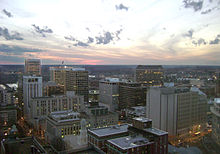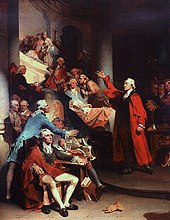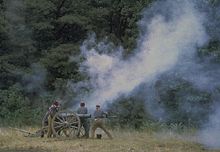Virginia
![]()
The title of this article is ambiguous. For other meanings, see Virginia (disambiguation).
Virginia (English pronunciation [![]()
![]() vɚˈd͡ʒɪnjə]), officially Commonwealth of Virginia, is a state of the United States of America comprising parts of the South Atlantic Coastal Plain, the Piedmont, and the Southern Appalachians. After more than 150 years as an Anglo-British colony, the Colony of Virginia gained independence along with twelve other colonies. In 1788, Virginia became the tenth state to ratify the U.S. Constitution. During the American Civil War, the northwestern counties seceded and became the independent state of West Virginia in 1862.
vɚˈd͡ʒɪnjə]), officially Commonwealth of Virginia, is a state of the United States of America comprising parts of the South Atlantic Coastal Plain, the Piedmont, and the Southern Appalachians. After more than 150 years as an Anglo-British colony, the Colony of Virginia gained independence along with twelve other colonies. In 1788, Virginia became the tenth state to ratify the U.S. Constitution. During the American Civil War, the northwestern counties seceded and became the independent state of West Virginia in 1862.
The state's nickname is Old Dominion ("Old Dominion"). It is also called Mother of the Presidents because eight US presidents came from Virginia. The capital is Richmond.
Geography
Geographical position
Virginia is located on the Atlantic coast of the United States roughly midway between the northern (Maine) and southern (Florida) expanses of the U.S. coastline. From the Atlantic coastal plain along the Chesapeake Bay to the heights of the Blue Ridge Mountains in the Appalachian Mountains in the western part of the state, the state has a topographical diversity. The southern border with North Carolina and Tennessee is an almost straight east-west line, while the northern border with Maryland and the District of Columbia is formed by the Potomac River. Kentucky and West Virginia are also direct neighbors on the west side of the Appalachian Mountains.
Virginia shares with the neighboring state of Maryland each just under half of the sprawling urban metropolitan area around the federal district of Washington, D.C. In addition to Dulles International Airport, this includes Arlington County, which is home to a number of American federal agencies, including the Pentagon. The western part of the county is home to Virginia's highest mountain, 1746-foot Mount Rogers. Also in the Appalachian Mountains is Shenandoah National Park.
Waters
The Eastern North American Continental Divide runs through Virginia. The major rivers in the eastern part of the state drain to the Chesapeake Bay, and in the southeast to Albemarle Sound in North Carolina. Major rivers of Virginia are the Potomac River with Shenandoah River and the Rappahannock River in the north, the James River in the center, and the Chowan and Roanoke Rivers in the southeast. The western part of the country beyond the watershed belongs to the Mississippi River basin. The most important rivers are the New River and the Clinch River.
Virginia has no natural lakes except Mountain Lake and Lake Drummond. The most stately lakes in the state were artificially created. Virginia's largest reservoir is the John H. Kerr Reservoir (200 km²), which extends into North Carolina. Completely within Virginia's territory is Smith Mountain Lake (83 km²), both reservoirs are located on the Roanoke River.
See also: List of rivers in Virginia
Structure
See also: List of counties in Virginia
Climate
The climate is mild compared to other U.S. states. Most of the state east of the Blue Ridge Mountains is dominated by a warm temperate rainfall climate (Class Cfa) according to the effective climate classification. In the mountainous regions west of the Blue Ridge Mountains, the climate is humid continental (Class Dfa).
However, some regional differences occur due to the diverse landscape relief. The greatest differences occur along the coasts of the Atlantic Ocean, in the Piedmont, and in the Blue Ridge and Allegheny Mountain ranges. The usually moderate influence of the ocean from the east, due to the Gulf Stream, alternates with brief storms caused by hurricanes at the mouth of the Chesapeake Bay. On the other hand, cold air masses from the mountains reach the state, especially in winter, bringing with them heavy snowfalls. The interaction of these climate extremes and topographic diversity provide microclimates in the Shenandoah Valley, which forms the mountainous southwest, and on the coastal prairies that differ slightly, yet to an appreciable degree, from the other regions. One climate element of recent years is the emergence of a heat island in northern Virginia, caused by the expansion of the metropolitan area around Washington, D.C., and the resulting increased heat output.
Climatic natural disasters are at times a serious problem. As mentioned above, hurricanes make the Virginia coast very vulnerable, although severe hurricanes rarely make landfall in the region, and when they do, they arrive in a weakened form. Far more often, the state is affected by other weather systems from the south, whose foothills bring torrential rains to the state. Thunderstorms are a concern at times, occurring 30 to 50 days a year depending on the region, with the frequency increasing westward. Conversely, eastern Virginia has a higher tornado rate; a statewide average of 10 tornadoes occur annually.

Richmond center
History
The name Virginia was given in honor of the English Queen Elizabeth I by Walter Raleigh in the course of his expedition of 1584, when he founded the first settlement on Roanoke Island. Since the unmarried queen had the epithet "Virgin Queen" (Virgin Queen) and, from the colonialists' point of view, it was ultimately about settling and reclaiming such land, this name was chosen. However, it once referred to an area that included the later states of Virginia, West Virginia, North Carolina, Kentucky, Tennessee and Ohio.
Of the native peoples of Virginia, the best known are the Powhatan, belonging to the Virginia Algonkin, who lived near the coast. Other groups were the Nottaway and Meherrin, belonging to the Iroquois language family, southwest of these; the Monacan and Saponi, belonging to the Sioux language family, who lived in the Appalachian foothills; and the Cherokee in the extreme west of the state.
Virginia was the site of the first settlement attempts by the English. However, these first attempts were not made by the English government, but by a company called the Virginia Company, which had founded the settlement of Jamestown in 1607. The English government at that time lacked the money to finance such expensive and uncertain expeditions. At first the attempts at settlement met with only moderate success. Of the 144 men launched in England in December 1606, only 38 were still alive nine months later; 39 had died during the crossing, 67 in the first nine months after arriving on the coast. Famine was also not uncommon, yet more and more Englishmen took the opportunity to emigrate to Virginia.
In the English Powhatan Wars, the colony came into severe distress. The year 1612 represents a very important year economically. John Rolfe planted the first tobacco plant, which he had probably brought from Trinidad, in Virginia. Due to the hot and humid climate and the help of the indigenous population, the tobacco plants thrived. Rolfe, who had married a Native American woman named Pocahontas in 1614, set out for England in 1616 with the first shipment of tobacco, where he experienced resounding success. In 1617, he returned to Virginia to further pursue tobacco farming, but without Pocahontas, who had died in England. Rolfe had started the first boom in the new English world. In 1618, 20,000 pounds of tobacco were exported; by 1638, exports totaled three million pounds. In 1706, Grace Sherwood was the last known person to be convicted of being a witch in Virginia.
The second governor of the colony became Lord De La Warr. German immigrants from the Siegerland founded the colony of Germanna in 1714. Germanna was named after Germany and the then British Queen Anne.
Home to many of the Founding Fathers, notably Patrick Henry, Thomas Jefferson, Richard Henry Lee, James Madison, George Mason, and George Washington, Virginia played a prominent role in the American Independence Movement. The British colonists were finally driven out of Virginia after the lost Battle of Great Bridge on December 9, 1775. The Virginia Convention, meeting in Williamsburg, declared Virginia independent on May 15, 1776. As part of its work on a constitution, it unanimously adopted a Declaration of Fundamental Rights - the Virginia Declaration of Rights - authoritatively formulated by George Mason on June 12, 1776. A few weeks later, the Convention finally elected Patrick Henry as Virginia's first governor. With the adoption of the United States Declaration of Independence by the Continental Congress on July 4 of that year, Virginia became one of the thirteen founding states of the United States.
In the conflict between Southern and Northern states that led to the American Civil War in 1861, Virginia was part of the Confederacy. On April 17, 1861, the State Convention convened in February passed the "secession ordinance". It was preceded by long and intense debates over the pros and cons of secession. Abraham Lincoln's call-up of troops after South Carolina's attack on Fort Sumter played a significant role in the decision to secede, arousing fears that the North would use military means to force the states that had left the Union to remain in it. Under these auspices, a majority emerged in the state convention in favor of secession. However, with 88 votes to 55, the vote was not as clear-cut as in most other secessionist states. However, this did not change the fact that Virginia was to become one of the most important theaters of the Civil War in the following four years, especially since it also provided the Confederate capital, Richmond.
The slave-free northwestern counties, on the other hand, declared on April 27, 1861 that they would secede from the state and remain in the Union. This part of Virginia became the 35th member state of the USA as West Virginia during the war in 1863.
On January 26, 1870, Virginia was readmitted to the Union after drafting a new constitution. However, it was not until after the First World War that the effects of the Civil War were completely overcome by means of the implementation of many comprehensive reforms. These were ordered by Democratic Governor Harry F. Byrd, Sr. in the 1920s and revived Virginia's economy, which had struggled for decades. However, racial tensions continued to linger.
Community centre
In colonial times, the lower house of government was called the House of Burgesses. Along with the Governor's Council, the House of Burgesses held the General Assembly. The Governor's Council consisted of twelve men appointed by the British monarch to appoint and advise the governor. It also functioned as the highest court in the colony, a colonial institution comparable to the British Supreme Court. Members of the House of Burgesses were chosen by all eligible voters in the colony. Each county elected two citizens to represent it; the College of William & Mary-the second oldest institution of higher learning in America after Harvard-and the towns of Norfolk, Williamsburg, and Jamestown each elected one citizen for this purpose.
The citizens met to pass laws for the colony and set the direction for the colony's future growth. The council considered the bills and approved or disapproved them. The approval of the citizens, the council, and the governor were required to pass a law. The idea of elected citizens was important and new. It gave the eligible voters of Virginia a way to control their government for the first time.
Initially, citizens were elected by all free men in the colony, while women, domestic servants, and Indians were not eligible to vote. Later, the election laws were tightened; it was now necessary to own at least 20 acres of land. Founded in 1619, the Virginia General Assembly is the oldest system of government still in existence in the New World. Today it is made up of the Senate and the House of Delegates. The term House of Burgesses has come to be used for all government of the period.

Patrick Henry in front of the town house in a picture by Peter F. Rothermel painted in 1851.

Reenactment of the Battle of Petersburg
Search within the encyclopedia